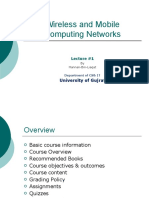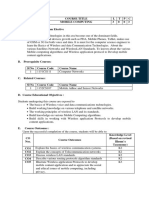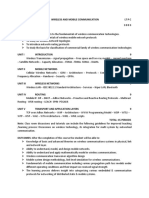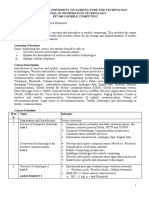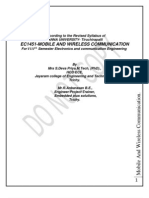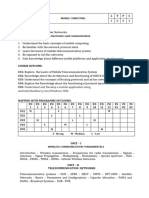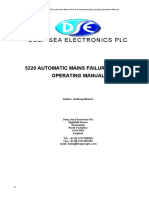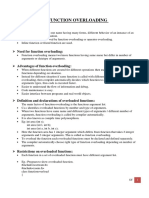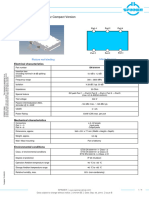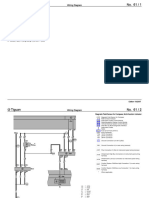WIRELESS NETWORKING AND MOBILE COMPUTING
Semester I (Computer Engineering)
SUB CODE: MECE103
Teaching Scheme (Credits and Hours)
Teaching scheme Total Evaluation Scheme
L T P Total Credit Theory Mid Sem CIA Pract. Total
Exam
Hrs Hrs Hrs Hrs Hrs Marks Marks Marks Marks Marks
03 00 02 05 04 3 70 30 20 30 150
LEARNING OBJECTIVES:
The objective of this course is
To know the details of TCP/IP
Understand working of Internet
Know application of TCP/IP
Manage TCP/IP and prepare foundation for future Networks
OUTLINE OF THE COURSE:
Unit No Topics
1 Wireless Networking
2 Wireless Networks
3 Introduction to Mobile Computing
4 Multiple Access Techniques
5 Mobile Network And Transport Layer
6 Mobile Ad hoc Network
Total hours (Theory): 45
Total hours (Practical): 30
Total hours: 75
Page 9 of 37
� DETAILED SYLLABUS:
Sr. Topic Lecture Weight age
No Hours (%)
1 Wireless Networking: 04 10
Introduction to Wireless Networking ,History of wireless networks,
Difference between Wireless and Fixed Telephone Networks,
Development of Wireless Networks, Wireless Network Architecture,
Benefits of Wireless Networks, Wireless Networking Applications
2 Wireless Networks: 12 25
Introduction, Wireless Technology
Satellite Communications: Parameters & configurations, Capacity
Allocation
Cellular Wireless Networks : Principles, Evolution
Wireless LANs: Technology,IEEE 802.11 Wireless LAN Standard,
Radio based Wireless
LANs,Components,Configuration,Performance, Wi-Fi, Wimax
3 Introduction to Mobile Computing: 08 17
Emerging Technologies, GSM, SMS, GPRS, EDGE, 3G, 4G
4 Multiple Access Techniques: 07 16
Frequency Division Multiple access, Time Division Multiple Access,
Aloha, Slotted Aloha, CSMA
5 Mobile Network And Transport Layer 07 16
Mobile IP- Goals and requirements, Entities, IP packet delivery,
Agent Discovery, Registration, Tunneling and Encapsulation,
Optimizations, Reverse Tunneling, IP micro-mobility support
DHCP
Traditional TCP-Congestion Control, Slow start, Fast retransmit/fast
recovery, Implications of mobility, Classical TCP- Indirect TCP,
snooping TCP, Mobile TCP, Transmission/time out freezing and
advancements
6 Mobile Ad hoc Network: 07 16
Introduction, Routing protocols- Routing, Dynamic source routing,
Destination sequence distance vector, Overview ad-hoc routing
protocols , Application- RFID, Bluetooth, Zigbee, NFC
Page 10 of 37
�INSTRUCTIONAL METHOD AND PEDAGOGY (Continuous Internal Assessment (CIA)
Scheme)
At the start of course, the course delivery pattern, prerequisite of the subject will be
discussed.
Lectures will be conducted with the aid of multi-media projector, black board, OHP etc.
Attendance is compulsory in lecture and laboratory which carries 10 marks in overall
evaluation.
Two internal exams will be conducted and average of the same will be converted to
equivalent of 15 Marks as a part of internal theory evaluation.
Assignments based on the course content will be given to the students for each unit and
will be evaluated at regular interval evaluation.
Surprise tests/Quizzes/Seminar/tutorial will be conducted having a share of five marks in
the overall internal evaluation.
The course includes a laboratory, where students have an opportunity to build an
appreciation for the concepts being taught in lectures.
Experiments shall be performed in the laboratory related to course contents.
STUDENTS LEARNING OUTCOMES:
On successful completion of the course, the student will be having the basic knowledge
of TCP/IP protocol suite and will understand the working of internet.
Student will be able to manage any TCP/IP network and also design optimized TCP/IP
network.
REFERENCE BOOKS:
1. Wireless Communications and Networks William Stallings Pearson Education
2. Mobile Communications Jochen Schiller Pearson
3. Wireless Communications Principles and Practice Theodore S. Rappaport.
4. Wireless Networking Kumar, Manjunath & Kuri, Morgan Kaufmann Publishers
5. Mobile Computing , Asoke K Telukder, Roopa R Yavagal, TMH
LIST OF PRACTICALS:
Sr.No Name of Experiment
1 Introduction to J2ME & Net beans
2 Introduction to WML
3 Programs on WML
4 WAP site using WML
5 Introduction to NS2
6 Simulation in wired n/w
7 Simulation in wireless n/w
8 Assignment on ns2
9 Assignment on ns2
10 Assignment on ns2
Page 11 of 37










